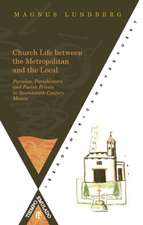Images and Power: Rock Art and Ethics: SpringerBriefs in Anthropology
Autor Polly Schaafsmaen Limba Engleză Paperback – 21 noi 2012
Preț: 382.95 lei
Nou
Puncte Express: 574
Preț estimativ în valută:
73.28€ • 76.71$ • 60.63£
73.28€ • 76.71$ • 60.63£
Carte tipărită la comandă
Livrare economică 05-19 aprilie
Preluare comenzi: 021 569.72.76
Specificații
ISBN-13: 9781461458210
ISBN-10: 1461458218
Pagini: 116
Ilustrații: XII, 104 p. 12 illus. in color.
Dimensiuni: 155 x 235 x 6 mm
Greutate: 0.3 kg
Ediția:2013
Editura: Springer
Colecția Springer
Seriile SpringerBriefs in Anthropology, Anthropology and Ethics
Locul publicării:New York, NY, United States
ISBN-10: 1461458218
Pagini: 116
Ilustrații: XII, 104 p. 12 illus. in color.
Dimensiuni: 155 x 235 x 6 mm
Greutate: 0.3 kg
Ediția:2013
Editura: Springer
Colecția Springer
Seriile SpringerBriefs in Anthropology, Anthropology and Ethics
Locul publicării:New York, NY, United States
Public țintă
ResearchCuprins
1.IntroductionIs it art?2. Ethics, Worldviews and Ways of KnowingCultural Landscapes, Cultural SpacesJudeo-Christian vs. American Indian Perspectives on Time and Space3. The Interpretation GameSome HistoryStrategies for Rock Art InterpretationGoals and Confusions: Conflicting ParadigmsRobbing the Non-material Past: Case Studies: Shamanism, WarfareRe-inventing the Past: Change, Desired Knowledge and Identity4. The Use and Re-Use of Imagery5. Discussion6. Conclusions
Recenzii
“Polly Schaafsma’s book on rock art and ethics is a thin volume but it packs in a lot of heavy food for thought. … this is an in-depth discussion of some of the most complex and contentious issues facing those who study, manage, or have an interest in rock art. The work is strongly and passionately argued and is sure to stimulate debate, the whole point of the Springer series.” (Jack W. Brink, Great Plains Research, Vol. 25 (1), 2015)
Notă biografică
As a Research Associate with the Museum of New Mexico, Polly Schaafsma has been engaged in rock art research since the early 1960s in the American Southwest. The pioneering descriptive and organizational efforts in the initial decades of rock art studies have matured to investigations involving world views, cosmology and meaning in the imagery. Her research has involved rock art from the Archaic hunter-gatherers to the Proto-historic and historic rock art of Pueblos, Navajos and Apaches with whom she has collaborated on several occasions. In the 1980s, she served on several committees in conjunction with members of nearby Pueblos in regard to the establishment of Petroglyph National Monument in Albuquerque and the subsequent issues surrounding outside impacts on the Monument. Recently as a member of the Cosmo group with the Santa Fe Institute, she has explored extensively issues and iconographies of New World cosmologies and the traditions shared by maize-based horticulturalists throughout.
Textul de pe ultima copertă
Images and Power: Rock Art and Ethics addresses the distinctive ways in which ethical considerations pertain to rock art research within the larger context of the archaeological ethical debate. Marks on stone, with their social and religious implications, give rise to distinctive ethical concerns within the scholarly enterprise as different perceptions between scholars and Native Americans are encountered in regard to worldviews, concepts of space, time, and in the interpretation of the imagery itself. This discourse addresses issues such as the conflicting paradigms of oral traditions and archaeological veracity, differing ideas about landscapes in which rock art occurs, the intrusion of “desired knowledge”, and how the past may be robbed by changing interpretations and values on both sides. Case studies are presented in regard to shamanism and war-related imagery. Also addressed are issues surrounding questions of art, aesthetics, and appropriation of imagery by outsiders. Overall, this discourse attempts to clarify points of contention between Euro-American scholars and Native Americans so that we can better recognize the origins of differences and thus promote better mutual understanding in these endeavors.
Caracteristici
Includes supplementary material: sn.pub/extras





















